Analysis by instruments on board the rover shows that the rock has qualities that meet the definition of a possible indicator of ancient life. The rock contains chemical signatures and structures that could have been formed by life billions of years ago, when there was flowing water in the area the rover was exploring. The science team is considering other explanations for the observed features, and further research will be needed to determine whether ancient life is a valid explanation.
NASA Perseverance rover scientists have discovered an interesting Martian rock. The six-wheeled geologist has found an interesting rock that, according to some data, could have been a habitat for microbial life billions of years ago.
A vein-filled rock is catching the attention of the NASA Perseverance rover science team. Dubbed “Cheyawa Falls” by the team, the arrowhead-shaped rock contains features that could answer the question of whether Mars was home to microscopic life in the distant past.
The rock, the 22nd rock sample collected by the rover, was collected July 21 as the rover explored the northern edge of the Neretva Valley, a quarter-mile-wide (400-meter) ancient river valley that was carved by water rushing into Jezero Crater many years ago.
“We designed Perseverance’s route to make sure it passed through areas with potential for interesting science samples,” said Nicola Fox, associate administrator for the Science Mission Directorate at NASA Headquarters in Washington. “This trip through the Neretva Valley paid off because we found something we’d never seen before, and it will give our scientists so much to study.”
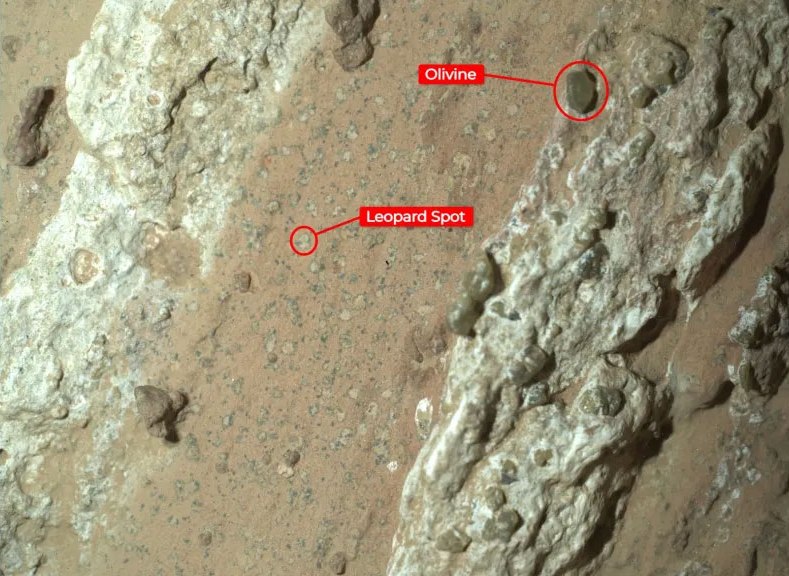
“Cheyawa Falls” shows leopard-like markings. July 18. NASA
Multiple scans of the Cheyawa Falls by the rover’s SHERLOC (Scanning Habitable Environments with Raman and Luminescence for Organic and Chemical Detection) instrument indicate that it contains organic compounds. While such carbon-based molecules are considered the building blocks of life, they can also be formed by non-biological processes.
“Cheyawa Falls is the most mysterious, complex, and potentially important rock Perseverance has ever explored,” said Ken Farley, a Perseverance project scientist at the California Institute of Technology in Pasadena. “On the one hand, we have the first convincing detection of organic material, distinctive color patches that indicate chemical reactions that microbial life could use as an energy source, and clear evidence that water — essential for life — once flowed through the rock. On the other hand, we haven’t been able to determine exactly how the rock formed or the extent to which nearby rocks might have heated Cheyawa Falls and contributed to these features.”
The group was also intrigued by other details about the stone, which measures 3.2 by 2 feet (1 by 0.6 meters) and was named after a waterfall in the Grand Canyon.
In its search for signs of ancient microbial life, Perseverance focused on rocks that may have been created or altered by the presence of water long ago. That’s why the team focused on Cheyawa Falls.
“This is exactly the kind of key observation that SHERLOC was designed to do — to look for organic matter, because it’s a critical component of the search for past life,” said SHERLOC principal investigator Kevin Hand of NASA’s Jet Propulsion Laboratory in Southern California, which manages the mission.
Large white veins of calcium sulfate run along the length of the rock. Between these veins are bands of material whose reddish color suggests the presence of hematite, one of the minerals that gives Mars its characteristic rusty hue.

NASA’s Perseverance rover used its Mastcam-Z instrument to capture this 360-degree panorama of a region on Mars called Bright Angel, where an ancient river flowed billions of years ago. Cheyava Falls was found in an area just right of center, about 361 feet (110 meters) from the rover. NASA/JPL-Caltech/ASU/MSSS
When Perseverance looked more closely at these red regions, it found dozens of irregular, millimeter-sized, off-white spots, each surrounded by black material similar to a leopard’s spots. Perseverance’s Planetary Instrument for X-ray Lithochemistry (PIXL) determined that these black halos contain both iron and phosphate.
“These spots were a big surprise,” said David Flannery, an astrobiologist and member of the Perseverance science team at the Queensland University of Technology in Australia. “On Earth, these kinds of features in rocks are often associated with fossilized traces of microbes living in the subsurface.”
These types of stains on sedimentary rocks on Earth can occur when chemical reactions involving hematite turn the rock from red to white. These reactions can also release iron and phosphate, which can lead to the formation of black halos. These types of reactions can be a source of energy for microbes, which explains the connection between these features and microbes in the terrestrial environment.
In one scenario considered by the Perseverance science team, Cheyawa Falls was initially deposited as mud with organic compounds that eventually cemented into the rock. Later, a second episode of liquid flow penetrated cracks in the rock, allowing mineral deposits to create the large white veins of calcium sulfate we see today and lead to the stains.
While both the organic matter and the leopard spots are of great interest, they are not the only aspects of the Cheyava Falls rock that have baffled the scientific team. They were surprised to find that the veins are filled with millimeter-sized crystals of olivine, a mineral that forms from magma. The olivine may be related to rocks that formed higher up along the edge of the river valley, which may have been produced by the crystallization of magma.
If so, the team must answer another question: could olivine and sulfate have been released into the rock at unacceptably high temperatures, causing an abiotic chemical reaction that led to the leopard spots?
“We’ve blasted this rock with lasers and X-rays and photographed it literally day and night from almost every angle imaginable,” Farley said. “From a scientific standpoint, Perseverance can’t do much else. To fully understand what really happened in that Martian river valley in Jezero Crater billions of years ago, we’d like to bring a sample from Cheyawa Falls back to Earth so it can be studied with the powerful tools available in labs.”
A key goal of Perseverance’s Mars mission is astrobiology, including caching samples that may contain signs of ancient microbial life. The rover will characterize the planet’s geology and past climate to help pave the way for human exploration of the Red Planet and be the first mission to collect and cache Martian rocks and regolith.
NASA’s Mars Sample Return program, in collaboration with ESA (the European Space Agency), aims to send spacecraft to Mars to collect sealed samples from the surface and return them to Earth for in-depth analysis.
The Mars 2020 Perseverance mission is part of NASA’s Mars Exploration from the Moon program, which includes the Artemis missions to the Moon that will help prepare for human exploration of the Red Planet.
NASA’s Jet Propulsion Laboratory, which is managed for the agency by the California Institute of Technology, built and operates the Perseverance rover.
A Martian rock sample retrieved from NASA’s Perseverance rover may contain the best evidence yet of possible ancient life. The lead scientist for NASA’s Perseverance rover is encouraged by the material stored in the rover’s sample tubes that were dropped on the surface of Mars and carried inside the rover as it moved through Jezero Crater.
Given the Mars samples Perseverance has collected so far, could one of those samples be what the rover was originally sent to find: evidence of past microbial life on the Red Planet?
The preliminary results of the study highlight the need to return samples from Mars to Earth so that these valuable artifacts from the Red Planet can be sent to laboratories for more thorough analysis.
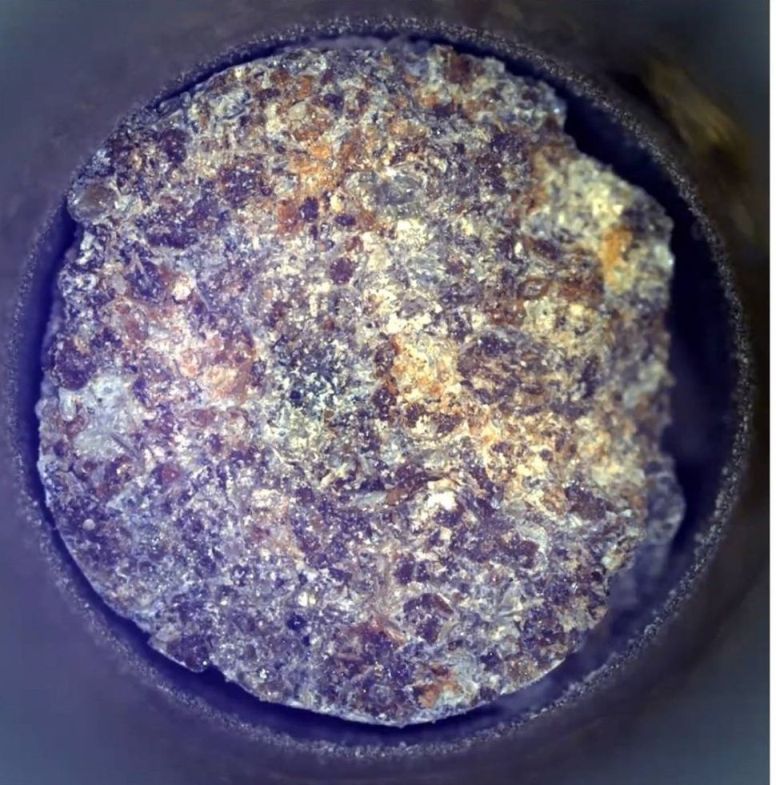
The sample, tagged Lefroy Bay in the Margin Unit, could have been deposited in either a lake or a groundwater system, both of which are important for understanding the habitability of Mars and the habitability of Jezero Crater. NASA/JPL-Caltech/Ken Farley
Kenneth Farley of the California Institute of Technology, a project scientist for NASA’s Perseverance rover, briefed the Extraterrestrial Materials Analysis Group (ExMAG) during a meeting held May 13-15 in Houston, Texas.
Under the tag “Lefroy Bay,” Farley drew attention to this sample collected by the Perseverance rover, which contains hydrated silica, the mineral with the highest potential to preserve signs of ancient life here on Earth.
But whether that water was surface water in a lake or river, or groundwater, remains unclear, Farley added. Both could represent ancient (more than 3.4 billion years old) habitable Martian environments, he said.
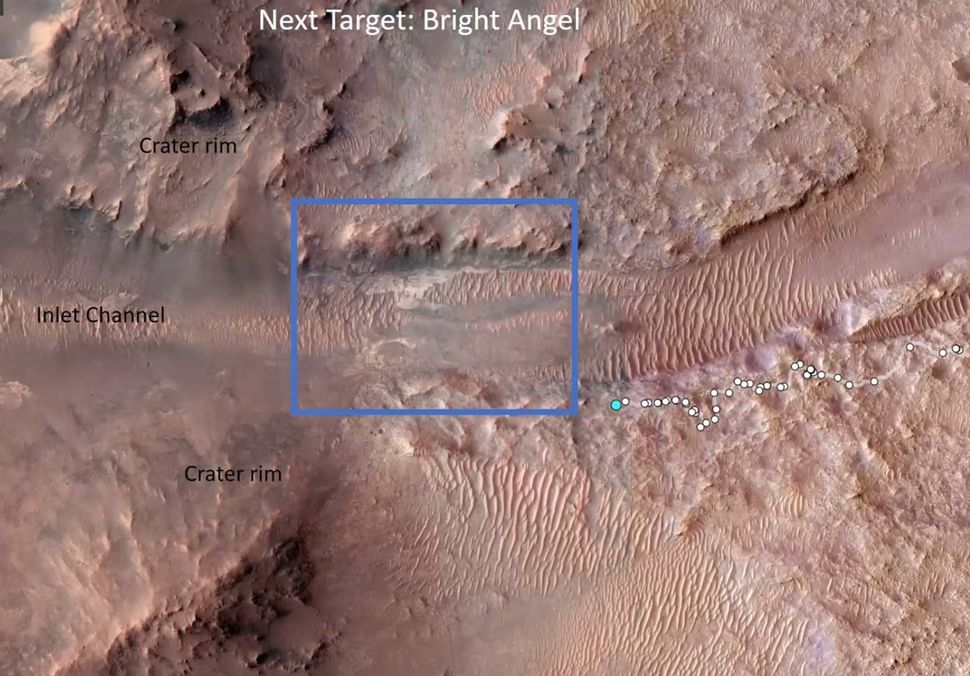
Perseverance’s next target is called “Bright Angel.” NASA/JPL-Caltech/Ken Farley
Farley noted that these samples contain phases that are very useful on Earth for establishing “paleoenvironmental” conditions, and they can also preserve biosignatures. “So these samples are uniquely valuable to return to Earth for further study,” Farley said.
Perseverance “is about to make a really fundamental transition in the exploration of the environment that we operate in,” Farley explained in his briefing for ExMAG. “One of the challenges we face,” he said, “is that the terrain is not very good for the rover to drive in.”
The Mars rover has now traveled about 17 miles (27 kilometers) since being lowered into the area by crane on February 18, 2021. The robot’s goal remains the same: “To search for signs of ancient life and collect rock and regolith samples for possible return to Earth,” NASA explains.
But why was the 28-mile-wide (45 km) Jezero Crater chosen as the rover’s exploration site? Scientists believe the area was once flooded with water and home to an ancient river delta. Jezero Crater is expected to spill out information about the on-again, off-again nature of Mars’s wet past. More than 3.5 billion years ago, river channels spilled over the crater wall to create a lake.
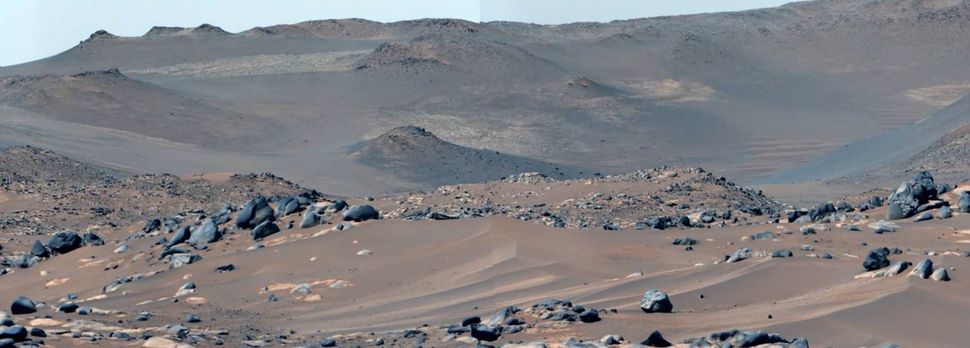
NASA’s Perseverance rover faces challenging terrain in Jezero Crater. NASA/JPL-Caltech/Ken Farley
It is possible that microbial life could have existed in Jezero during one or more of these wet periods. If true, traces of the remains of these small creatures could be found in lake or shore sediments.
As for the overall health of the Perseverance rover, Farley noted several problems: first, the loss of wind sensors that are part of the Mars Environmental Dynamics Analyzer (MEDA), built by an international team led by Spain’s Centro de Astrobiología. “We’ve pretty much lost the wind sensors. They’re basically not functioning anymore,” he said.
Additionally, the spectroscopic parts of the Scanning Habitable Environments with Raman & Luminescence for Organics & Chemicals robotic arm, or SHERLOC for short, are in question. That’s because the lens cover no longer works properly. However, there is some preliminary work suggesting that scientists may be able to restore SHERLOC’s spectroscopic capabilities. “We’ll learn more about that in the coming months,” Farley said.
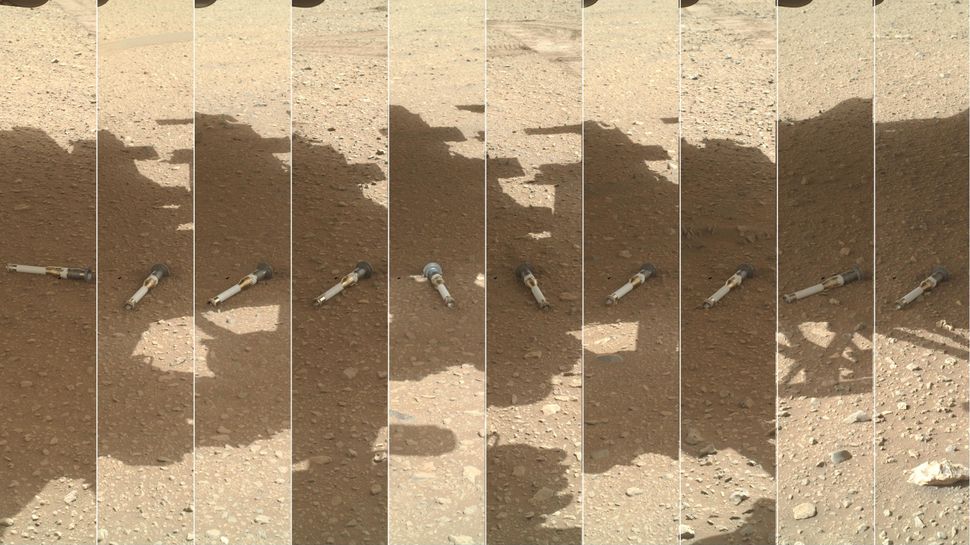
This photo montage shows each of the sample tubes delivered by NASA’s Perseverance rover to the Three Forks sample storage facility, as seen by the WATSON camera on the end of the rover’s robotic arm. NASA/JPL-Caltech/MSSS
The robot on duty collected samples of igneous rocks, mudstone, sandstone/pebble conglomerate, carbonate, silica and olivine, as well as upper Martian sand, and captured the scent of the Martian atmosphere.
Earlier in its voyage to Mars, Perseverance dropped 10 sealed sample tubes at a storage site called Three Forks in Jezero Crater. The Mars Sample Return (MSR) mission is expected to pick up the sample tubes in the future to send those bits and pieces of Mars back to Earth.
However, this joint NASA-European Space Agency project is currently undergoing a detailed rethink due to the estimated cost of $11 billion and the expected, but unsatisfactory, time frame for the implementation of such a complex project.
Farley told the ExMAG team that rover operators are working to give Perseverance a range of 55 miles (90 kilometers), which would allow it to explore scenic landscapes.
Artificial intelligence is helping scientists identify minerals in rocks studied by the Perseverance rover.
Some scientists dream of exploring planets with “smart” spacecraft that know exactly what data to look for, where to find it, and how to analyze it. While that dream will take time to become a reality, the successes of NASA’s Perseverance rover offer promising steps in that direction.
For nearly three years, the rover mission has been testing a form of artificial intelligence that searches for minerals in the Red Planet’s rocks. It’s the first time AI has been used on Mars to make autonomous decisions based on real-time analysis of rock composition.
The software supports PIXL (Planetary Instrument for X-ray Lithochemistry), a spectrometer developed by NASA’s Jet Propulsion Laboratory in Southern California. By mapping the chemical composition of minerals on a rock’s surface, PIXL allows scientists to determine whether the rock formed under conditions that could have supported microbial life in Mars’s ancient past.
Called “adaptive sampling,” the software autonomously positions the instrument near a target rock and then looks at PIXL scans of the target to find minerals worth studying in more depth. This is all done in real time, without the rover communicating with mission controllers on Earth.
“We use PIXL’s artificial intelligence to focus on the key science,” said the instrument’s principal investigator, Abigail Allwood of JPL. “Without it, you’d see a hint of something interesting in the data, and then you’d have to rescan the rock to study it in more detail. This allows PIXL to come to a conclusion without humans looking at the data.”
Data from Perseverance’s instruments, including PIXL, are helping scientists determine when to drill a core of rock and seal it in a titanium metal tube so it can be returned to Earth along with other high-priority samples for further study as part of NASA’s Mars Sample Return Campaign.
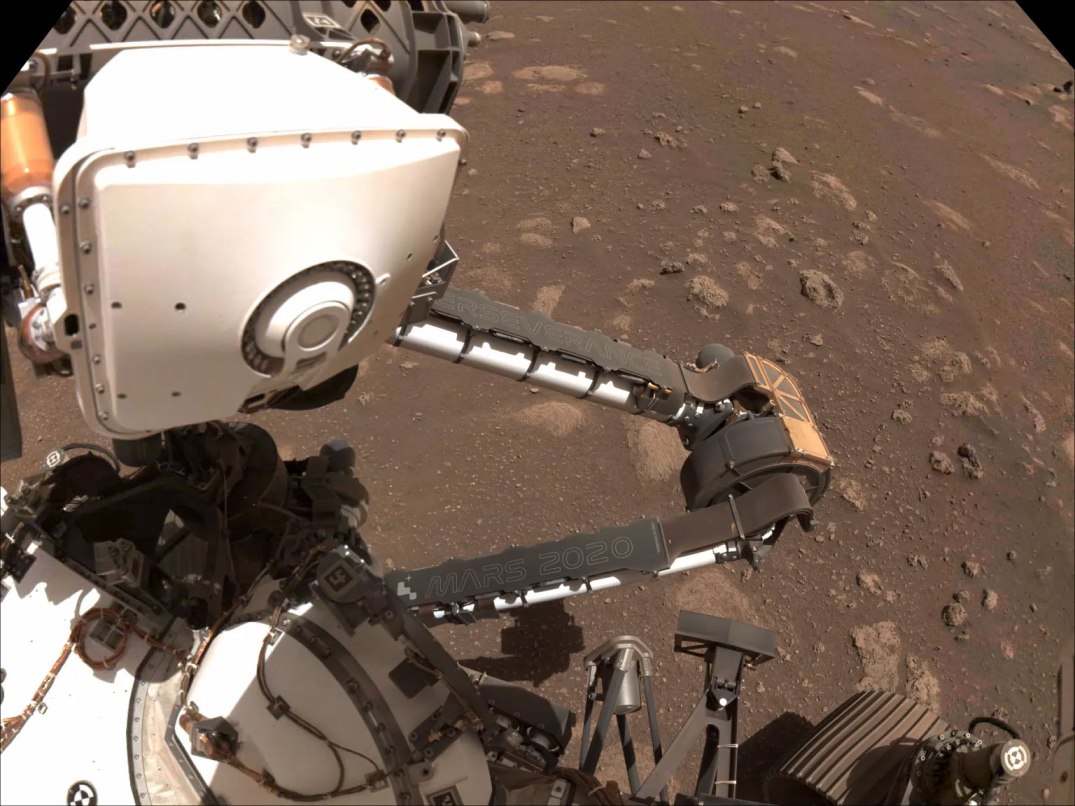
PIXL, the white instrument at top left, is one of several science instruments located at the end of a robotic arm aboard NASA’s Perseverance rover. The rover’s left navigation camera captured the images that make up this composite on March 2, 2021. NASA/JPL-Caltech
Adaptive sampling isn’t the only application of AI on Mars. About 2,300 miles (3,700 kilometers) away from Perseverance, NASA’s Curiosity has pioneered a form of AI that allows the rover to autonomously hit rocks with lasers based on their shape and color. By studying the gas that burns off after each laser strike, it can determine the rock’s chemical composition. Perseverance has the same ability, plus a more advanced form of AI that allows it to navigate without specific instructions from Earth. Both rovers still rely on dozens of engineers and scientists to plan a daily set of hundreds of individual commands, but these digital intelligences are helping both missions do more in less time.
“The idea behind PIXL adaptive sampling is to help scientists find the needle in the haystack of data, freeing up time and energy to focus on other things,” said Peter Lawson, who led the implementation of adaptive sampling before leaving JPL. “Ultimately, it helps us collect better science data faster.”
AI helps PIXL in two ways. First, it positions the instrument precisely once it’s close to the rock target. The spectrometer, located at the end of Perseverance’s robotic arm, is mounted on six tiny robotic legs called hexapods. PIXL’s camera repeatedly checks the distance between the instrument and the rock target to help with positioning.
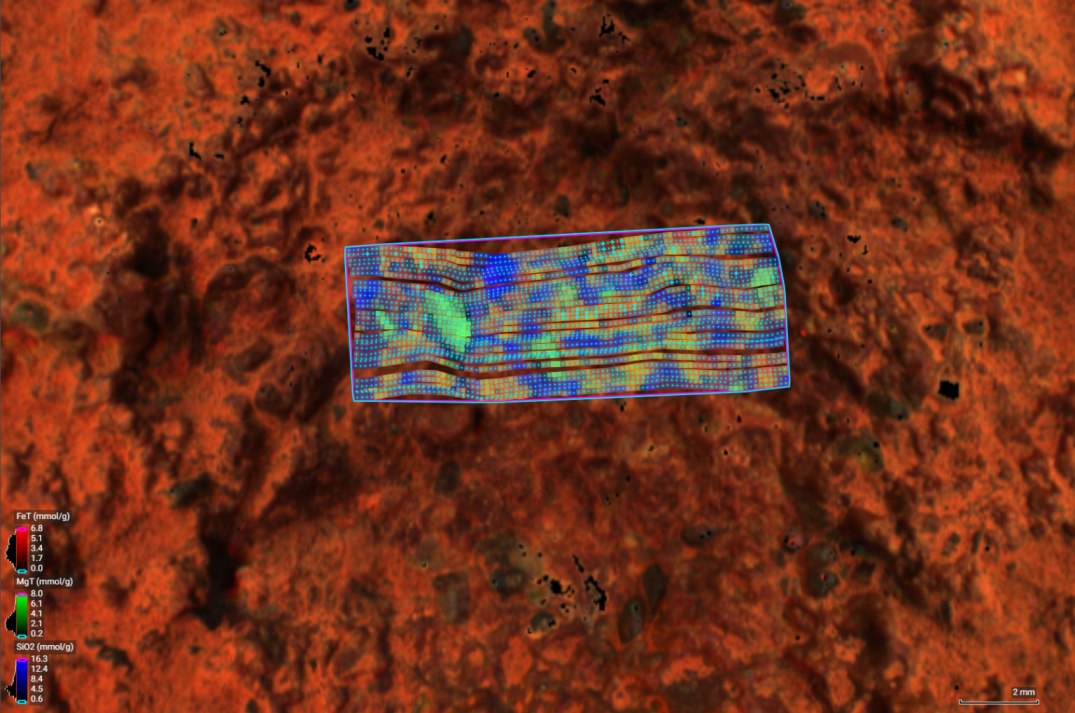
This image of a rock target called Thunder Peak was taken by NASA’s Perseverance rover using PIXL, which determines the mineral composition of rocks by shining X-rays on them. Each blue dot in the image represents where an X-ray hit. NASA/JPL-Caltech/DTU/QUT
Temperature variations on Mars are so large that Perseverance’s arm would expand or contract by microscopic amounts, which could throw off PIXL’s aim. The hexapod automatically adjusts the instrument to stay extremely close without touching the rock.
“We have to make adjustments to the micrometer scale to get the accuracy we need,” Allwood said. “He gets so close to the rock that it makes the hair on the back of an engineer’s neck stand up.”
Once PIXL is in place, another AI system gets a chance to shine. PIXL scans a postage stamp-sized area of the rock, firing off X-rays thousands of times to create a grid of microscopic dots. Each dot reveals information about the chemical makeup of the minerals present.
Minerals are crucial to answering key questions about Mars. Depending on the rock, scientists may be hunting for carbonates, which hide clues about how water may have formed the rock, or they may be looking for phosphates, which could provide nutrients for microbes if they were present in Mars’s past.
Scientists can’t know in advance which of the hundreds of X-ray pulses will reveal a particular mineral, but when the instrument finds certain minerals, it can automatically pause to collect more data — an action called a “long exposure.” As the system improves with machine learning, the list of minerals PIXL can focus on with a long exposure grows.
“PIXL is kind of a Swiss Army knife because it can be customized based on what scientists are looking for at any given time,” said David Thompson of JPL, who helped develop the software. “Mars is a great place to test AI because we have regular, daily communications, which gives us the ability to make adjustments as we go.”
As future missions travel deeper into the solar system, they will be out of contact for longer periods than current Mars missions. That’s why there’s a lot of interest in developing greater autonomy for missions as they roam and conduct scientific research for the benefit of humanity.
Every rock and soil sample collected by the Perseverance rover contains a potential discovery for atmospheric scientists.
Atmospheric scientists are growing more excited with each rock core that NASA’s Perseverance rover seals into titanium sample tubes to be collected for return to Earth as part of the Mars Sample Return Campaign. Twenty-four have been collected so far.
Most of these samples consist of cores of rocks or regolith (rock fragments and dust), which could reveal important information about the planet’s history and whether microbial life existed billions of years ago. But some scientists are also excited by the prospect of studying “headspace,” or the air in the extra space around the rock material in the tubes.
They want to learn more about the Martian atmosphere, which is mostly carbon dioxide but may also include trace amounts of other gases that may have been present on the planet since its formation.

“Air samples from Mars will tell us not only about the current climate and atmosphere, but also how they have changed over time,” said Brandi Carrier, a planetary scientist at NASA’s Jet Propulsion Laboratory in Southern California. “This will help us understand how climates different from our own evolve.”
Among the samples that could be returned to Earth is one tube filled solely with gas, deposited on the Martian surface as part of a sample cache. But much more of the gas in the rover’s collection is in the headspace of the rock samples. They are unique because the gas will interact with the rocks inside the tubes for years before the samples can be opened and analyzed in labs on Earth. What scientists learn from them will provide insight into how much water vapor hovers near the Martian surface, one of the factors that determines why ice forms where it does on the planet, and how Mars’s water cycle has evolved over time.
Scientists also want to better understand the trace gases in Mars’s air. The most scientifically interesting would be the detection of noble gases (such as neon, argon, and xenon), which are so unreactive that they could have been around, unchanged in the atmosphere, since they formed billions of years ago. If captured, these gases could reveal whether Mars had an atmosphere. (Ancient Mars had a much thicker atmosphere than it does today, but scientists aren’t sure whether it was always there or formed later.) There are also big questions about how the planet’s ancient atmosphere compared to Earth’s early atmosphere.
In addition, the air gap will provide an opportunity to assess the size and toxicity of dust particles – information that will help future astronauts on Mars.
“Gas samples have a lot to offer scientists studying Mars,” said Justin Simon, a geochemist at NASA’s Johnson Space Center in Houston who is part of a group of more than a dozen international experts who are helping decide what samples the rover should collect. “Even scientists who don’t study Mars would be interested because it would shed light on how planets form and evolve.”
In 2021, a team of planetary scientists, including scientists from NASA, studied air brought back from the Moon in a steel container by the Apollo 17 astronauts about 50 years ago.
“People think of the moon as airless, but it has a very thin atmosphere that interacts with lunar surface rocks over time,” said Simon, who studies a variety of planetary samples at Johnson. “This includes noble gases that flow out of the moon’s interior and collect on the lunar surface.”
The way Simon’s team extracted the gas for study is similar to what might be done with Perseverance’s air samples. First, they placed a previously unopened container in a sealed shell. Then they pierced the steel with a needle to extract the gas into a cold trap — essentially a U-shaped tube that extends into a liquid, like nitrogen, with a low freezing point. By varying the temperature of the liquid, the scientists trapped some of the gases with lower freezing points at the bottom of the cold trap.
“There are probably 25 labs in the world that are manipulating gas in this way,” Simon said. In addition to being used to study the origins of planetary materials, the approach could be applied to gases from hot springs and those that come out of the walls of active volcanoes, he added.
Of course, these sources provide far more gas than Perseverance has in its sample tubes. But if one tube doesn’t carry enough gas for a particular experiment, Mars scientists can combine gases from multiple tubes to produce a larger, aggregate sample—another way that extra space provides a bonus opportunity for science.
In June, after six months of effort, an instrument that helps the rover search for potential signs of ancient microbial life was back in action. The SHERLOC (Scanning Habitable Environments with Raman and Luminescence for Organics and Chemicals) instrument aboard NASA’s Perseverance rover analyzed a rock target with a spectrometer and camera for the first time since the problem arose last January. The instrument plays a key role in the mission’s search for signs of ancient microbial life on Mars. Engineers at NASA’s Jet Propulsion Laboratory in Southern California confirmed on June 17 that the instrument had successfully collected data.
“Six months of diagnostics, testing, image and data analysis, troubleshooting and retesting could not have led to a better conclusion,” said SHERLOC principal investigator Kevin Hand of JPL.
Mounted on the rover’s robotic arm, SHERLOC uses two cameras and a laser spectrometer to search for organic compounds and minerals in rocks that have been altered by aquatic environments and may contain signs of past microbial life. On January 6, a movable lens cover designed to protect the instrument’s spectrometer and one of its cameras from dust froze in a position that prevented SHERLOC from collecting data.
The SHERLOC team’s analysis pointed to a malfunction in a small motor responsible for moving the lens cover and adjusting the focus for the spectrometer and the Autofocus and Context Imager (ACI) camera. After testing potential solutions on a duplicate SHERLOC instrument at JPL, the team began a long and rigorous evaluation process to determine whether and how the lens cover could be moved to the open position.
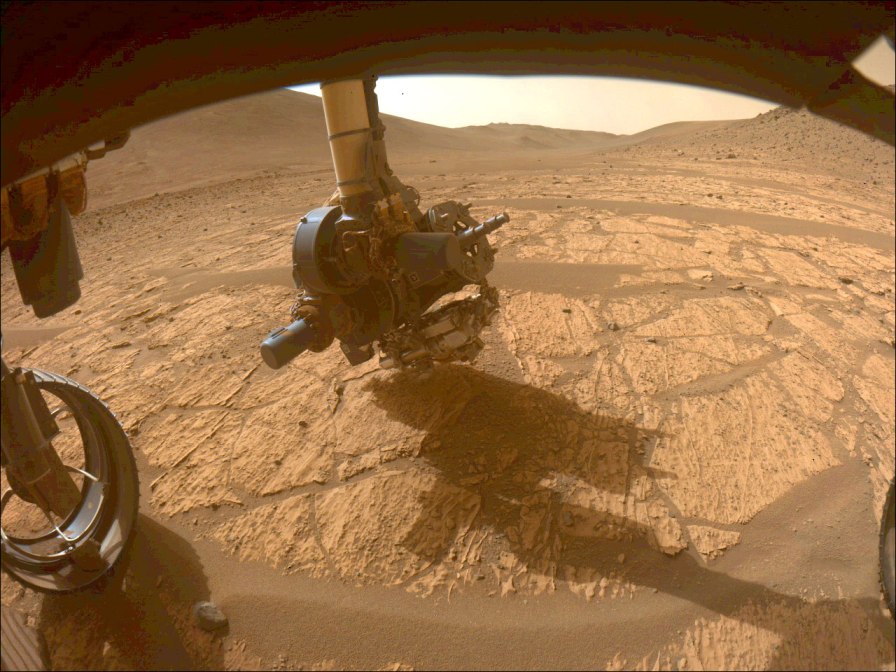
This image of NASA’s Perseverance rover collecting abrasion data on the Wallhalla Glades was taken in the Bright Angel region of Jezero Crater by one of the rover’s forward hazard detection cameras on June 14. The WATSON camera on the SHERLOC instrument is closest to the surface of Mars. NASA/JPL-Caltech
“The rover’s robotic arm is amazing. It can be controlled in small quarter-millimeter steps to help us estimate the new focus position of SHERLOC, and it can place SHERLOC on a target with high precision,” Uckert said. “After testing first on Earth and then on Mars, we found that the best distance for the robotic arm to place SHERLOC is about 40 millimeters,” or 1.58 inches. “At that distance, the data we collect should be as accurate as ever.”
Confirmation of ACI’s precise positioning on the Martian rock target came on May 20. A June 17 check that the spectrometer was also functioning confirmed the team’s final point, confirming that SHERLOC was operational.
“Mars is tough, and bringing instruments back from the brink is even tougher,” said Perseverance project manager Art Thompson of JPL. “But the team never gave up. With SHERLOC back on the job, we’re continuing our exploration and sample collection with a full suite of science instruments.”
Perseverance is in the final stages of its fourth science campaign, searching for evidence of carbonate and olivine deposits in the Margin Unit, an area along the inner rim of Jezero Crater. On Earth, carbonates typically form in shallow freshwater or alkaline lakes. This is thought to be the case in the Margin Unit, which formed more than 3 billion years ago.
The spacecraft that will catch a sample of the Martian surface moving in Martian orbit and deliver it to Earth has passed its design review.
While NASA’s Mars sample return mission is in budget limbo, the European Space Agency (ESA) continues to work on its piece of the Red Planet sample collection puzzle: the Earth Return Orbiter (ERO).
ERO will provide the critical transportation of Mars samples collected by NASA’s Perseverance rover from the Red Planet to Earth. To do this, it will rendezvous with the sample in Martian orbit, catch the basketball-sized capsule as it whizzes around the planet, and finally return it to Earth.
The spacecraft has just passed a design review that has validated its technical details and is moving the project into the manufacturing and testing phase. “A robust design is the foundation for building, testing and assembling the hardware into a complete spacecraft,” ERO project team leader Tiago Loureiro said in a statement.
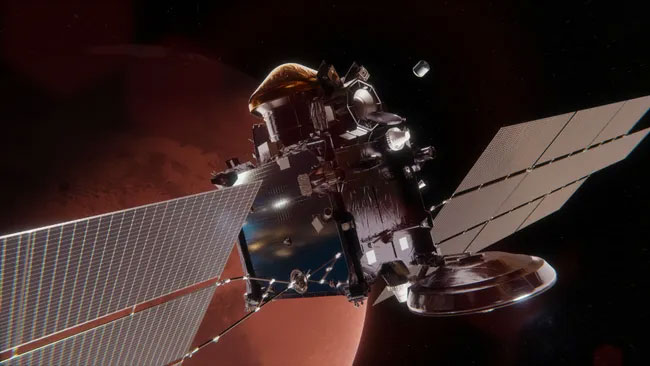
Artist’s impression of the Earth Return Orbiter (ERO). Airbus/ESA
“From a staggering distance of several hundred million kilometres, ground teams will choreograph complex orbital dances around Mars,” said Orson Sutherland, ESA’s Mars programme manager.
While the European Space Agency’s (ESA) ERO programme is moving forward, the part of NASA’s mission that involves transporting a sample to the surface of Mars and using the Mars Ascent Vehicle rocket to launch it into Martian orbit is still under review after its $11 billion budget was deemed too expensive.
As such, it could face numerous design changes in the near future. In fact, NASA recently commissioned ten studies to reduce the scale (and therefore cost) of the mission.
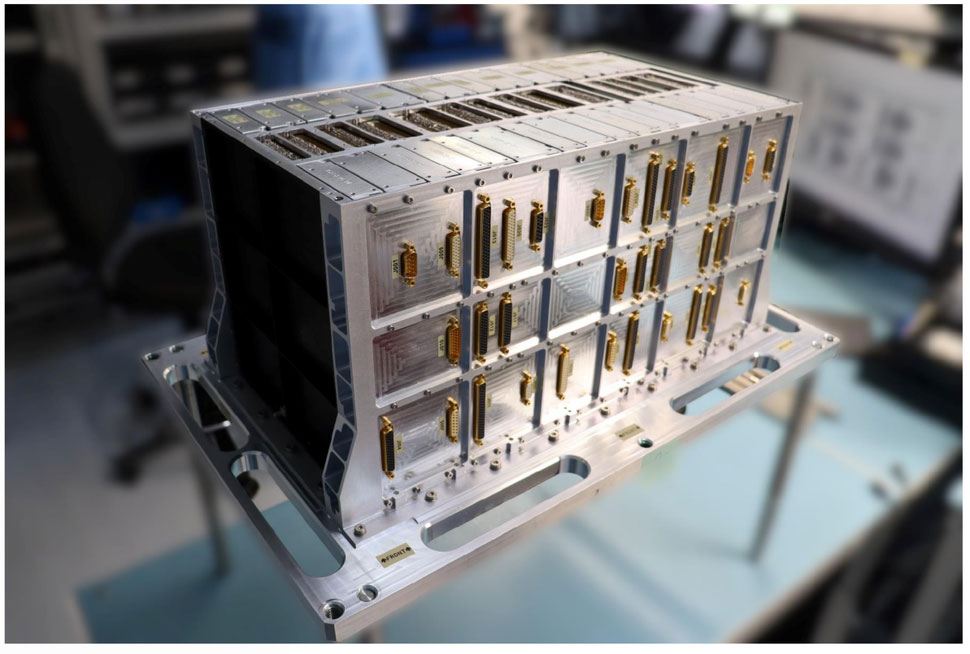
An engineering qualification model of the Earth Return Orbiter Remote Interface Unit (RIU). The RIU connects much of the spacecraft’s hardware, such as sensors and actuators including chemical propulsion valves, flywheels, control relays and temperature sensors, to the main computer. It is a replica of the flight model, and is being used to test it in conditions that should be harsher than those engineers expect to encounter on a mission to Mars. Airbus/ESA
But ESA confirms that ERO will be able to adapt to any changes to the Mars Sample Return mission. “The spacecraft configuration is robust enough to be flexible with the payload and to help find solutions for new architectures. ESA and our industrial partners have adapted to the new scenario by remaining inventive and resourceful, remaining a reliable partner for NASA,” said Tiago. “We have confirmed that Earth Return Orbiter performs as planned and even better, whatever the alternatives.”
The new Rosalind Franklin rover, led by ESA (European Space Agency), will be sent to Mars no earlier than 2028.
The Mars Organic Molecule Analyzer (MOMA), a mass spectrometry instrument on board the rover, will analyze samples collected by the drill and send the results back to Earth, where they will be used in an algorithm to identify organic compounds found in the samples.
If the rover detects any organic compounds, the algorithm could significantly speed up the process of identifying them, saving scientists time in deciding how best to use the rover’s time on the Red Planet.
When a robotic rover lands on another planet, scientists have a limited amount of time to collect data from the many materials being studied due to the short duration of the mission and the length of time needed to conduct complex experiments.
That’s why researchers at NASA’s Goddard Space Flight Center in Greenbelt, Maryland, are exploring the use of machine learning to speed up the analysis of data collected from the rover’s samples and help scientists on Earth develop strategies for making the most of the rover’s time on the planet.
“This machine learning algorithm can help us by quickly filtering the data and indicating which data is likely to be the most interesting or important to study,” said Xiang “Sean” Li, a mass spectrometry scientist at the Planetary Environment Laboratory at NASA Goddard.
The algorithm will first be tested on data from Mars by running it on a ground computer using data collected by the Mars Organic Molecule Analyzer (MOMA) instrument.
The analyzer is one of the main scientific instruments of the upcoming ExoMars Rosalind Franklin Rover mission, led by ESA (European Space Agency). The rover, scheduled to launch no earlier than 2028, aims to determine whether life ever existed on the Red Planet.
After Rosalind Franklin collects the sample and analyzes it using MOMA, the data will be sent back to Earth, where scientists will use the data to decide on the best course of action.
“For example, if we measure a sample that shows signs of large complex organic compounds mixed with certain minerals, we might want to do a deeper analysis of that sample or even recommend that the rover collect another sample using a drill,” Li said.
An algorithm could help determine the chemical composition beneath the surface of Mars. In the field of artificial intelligence, machine learning is a way for computers to learn from data (big amounts of data), identifying patterns and making decisions or drawing conclusions.
This automated process can be effective when patterns may not be obvious to human researchers viewing the same data, which is typical for large and complex datasets such as those used in visualization and spectral analysis.
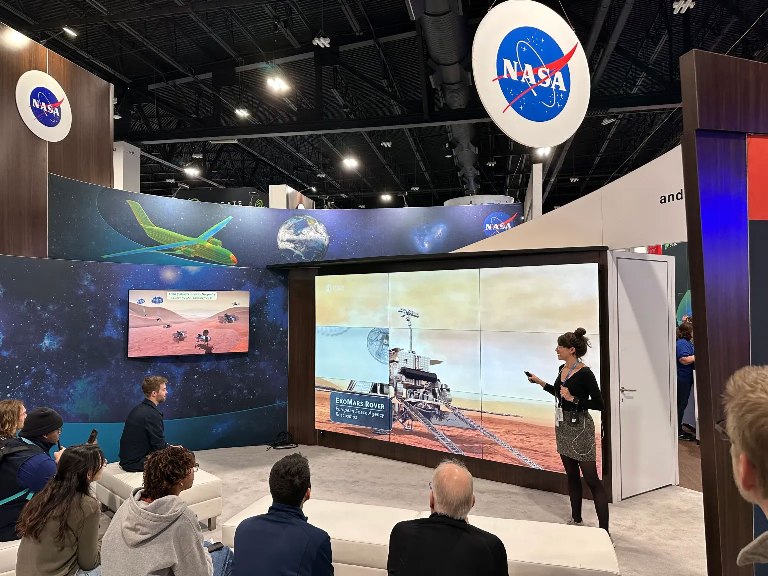
NASA data scientist Victoria Da Poian presents the MOMA machine learning algorithm at the Supercomputing 2023 conference in Denver, Colorado. NASA/Donovan Matias
In the case of MOMA, the researchers collected lab data for more than a decade, according to Victoria Da Poian, a data scientist at NASA Goddard who co-led the development of the machine-learning algorithm. The scientists train the algorithm by giving it examples of substances that might be found on Mars and labeling them. The algorithm will then use the MOMA data as input and output predictions of the chemical composition of the sample being studied based on its training.
“The more we do to optimize data analysis, the more information and time scientists will have to interpret the data,” Da Poyang said. “That way, we can quickly respond to the results and plan the next steps as if we were there with the rover, much faster than before.”
What makes the Rosalind Franklin rover unique — and what scientists hope will lead to new discoveries — is that it will be able to drill into the surface of Mars to a depth of about 6.6 feet (2 meters). Previous rovers have only reached about 2.8 inches (7 centimeters) below the surface.
“Organic materials on the surface of Mars are more likely to be destroyed by radiation at the surface and cosmic rays that penetrate into the subsurface,” Li said, “but two meters of depth should be enough to protect most organic matter. MOMA therefore has the potential to detect preserved ancient organics, which would be an important step in the search for past life.”




